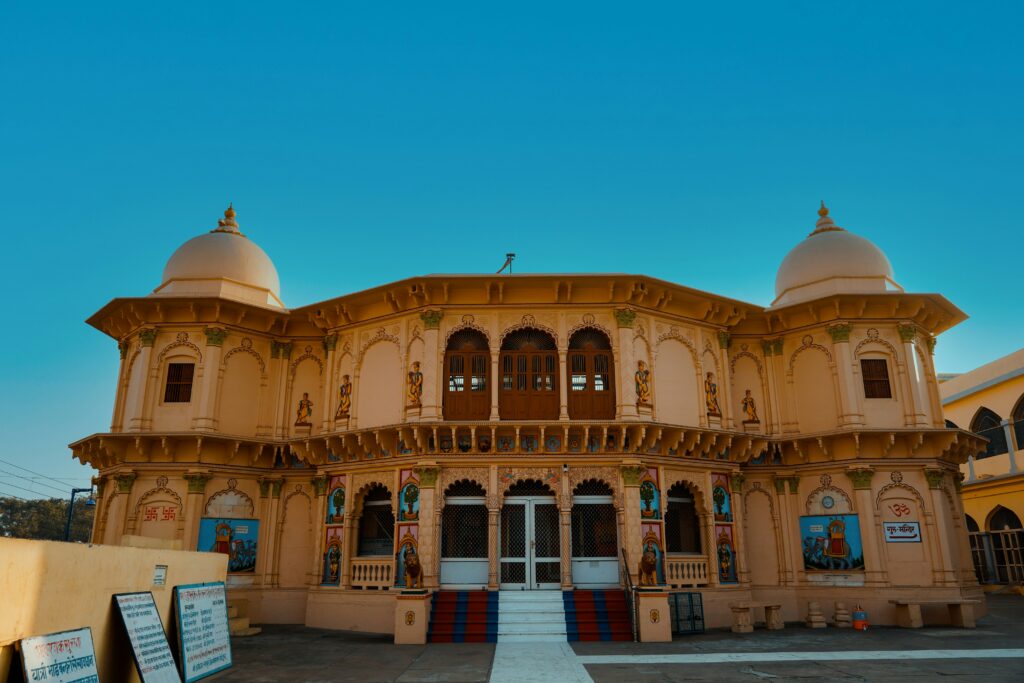Ayodhya, nestled on the banks of the sacred Saryu River in Uttar Pradesh, is one of India’s most revered spiritual destinations.Ayodhya tourist places include Ram Janmabhoomi, Hanuman Garhi, Kanak Bhawan, Saryu Ghat, and Nageshwarnath Temple — each offering a blend of spiritual depth, historical significance, and cultural charm Known as the birthplace of Lord Ram, Ayodhya holds immense religious significance for Hindus and is deeply woven into the fabric of the Ramayana. But beyond its mythological legacy, Ayodhya offers a rich tapestry of temples, ghats, heritage sites, and cultural experiences that make it a compelling destination for all kinds of travelers.
Whether you’re a pilgrim seeking divine blessings, a history enthusiast exploring ancient architecture, or a curious tourist looking for serenity and stories — Ayodhya has something for you.
🛕 1. Ram Janmabhoomi (Ram Mandir)
The heart of Ayodhya’s spiritual identity, Ram Janmabhoomi is believed to be the exact birthplace of Lord Ram. The newly constructed Ram Mandir, inaugurated in January 2024, is a stunning architectural marvel that blends tradition with grandeur. The temple’s sanctum houses the idol of Bala Ram (child form of Lord Ram), and the entire complex is designed to reflect Hindu cultural aesthetics.
- Highlights: Ram Lalla Darshan, temple architecture, spiritual ambiance.
- Best time to visit: Early morning or evening aarti hours.
🏯 2. Hanuman Garhi
Just 1.5 km from Ram Mandir, Hanuman Garhi is a 10th-century temple dedicated to Lord Hanuman. It is customary for devotees to visit Hanuman Garhi before entering Ram Mandir, as Hanuman is considered the guardian of Ayodhya. The temple is perched atop 76 steps and offers panoramic views of the city.
- Highlights: Hanuman idol, hilltop views, spiritual rituals.
- Best time to visit: Morning hours for less crowd and peaceful darshan.
🏰 3. Kanak Bhawan
Known as the “Palace of Gold,” Kanak Bhawan is a beautiful temple dedicated to Lord Ram and Goddess Sita. According to legend, it was gifted to Sita by Queen Kaikeyi after her marriage. The temple houses golden-crowned idols of Ram and Sita under a silver canopy, making it a visual and spiritual delight.
- Highlights: Intricate carvings, golden idols, peaceful courtyard.
- Best time to visit: Afternoon for quiet reflection.
🌊 4. Saryu Ghat
The ghats of the Saryu River are central to Ayodhya’s spiritual life. Devotees take holy dips in the river, especially during festivals and auspicious days. The evening aarti at Saryu Ghat is a mesmerizing experience, with hundreds of lamps illuminating the riverfront and chants echoing through the air.
- Highlights: Boat rides, evening aarti, sunrise views.
- Best time to visit: Sunset for the aarti or sunrise for tranquility.
🕉️ 5. Nageshwarnath Temple
Dedicated to Lord Shiva, Nageshwarnath Temple is believed to have been built by Kush, the son of Lord Ram. It’s one of the oldest temples in Ayodhya and holds special significance during Maha Shivratri. The temple’s architecture reflects a blend of ancient and medieval styles.
- Highlights: Shiva linga, historical significance, festive celebrations.
- Best time to visit: During Maha Shivratri or early mornings.
🛕 6. Dashrath Bhavan
This is believed to be the royal residence of King Dashrath, Lord Ram’s father. Located in the heart of Ayodhya, Dashrath Bhavan is a spiritual site where devotees can witness rituals and recitations of Ramayana. The ambiance is serene and filled with devotional energy.
- Highlights: Ramayana chanting, spiritual gatherings, heritage architecture.
- Best time to visit: During Ram Navami celebrations.
🏛️ 7. Shri Sita Rasoi
Located near Ram Janmabhoomi, Shri Sita Rasoi is a symbolic kitchen believed to be used by Goddess Sita. It now functions as a temple and museum showcasing utensils and artifacts associated with the Ramayana era.
- Highlights: Cultural exhibits, spiritual symbolism.
- Best time to visit: Midday for guided tours.
🕌 8. Gulab Bari
A Mughal-era garden and tomb complex, Gulab Bari is the resting place of Nawab Shuja-ud-Daula. It features symmetrical gardens, fountains, and Islamic architecture, offering a glimpse into Ayodhya’s diverse cultural past.
- Highlights: Mughal architecture, rose gardens, historical significance.
- Best time to visit: Morning or late afternoon.
🕌 9. Raj Dwar Mandir
This temple is dedicated to Lord Ram and is known for its peaceful ambiance and spiritual energy. It’s less crowded than other major temples and offers a quiet space for meditation and reflection.
- Highlights: Spiritual serenity, local rituals.
- Best time to visit: Anytime during the day.
🕌 10. Imambada
Ayodhya’s Imambada reflects its syncretic heritage. It’s a Shia Muslim religious site that showcases Indo-Islamic architecture and is visited by those interested in Ayodhya’s pluralistic history.
- Highlights: Architecture, cultural harmony.
- Best time to visit: During Muharram or heritage walks.
📅 Best Time to Visit Ayodhya
- October to March: Pleasant weather, ideal for sightseeing and temple visits.
- April to June: Hot but manageable for early morning tours.
- Festivals to experience:
- Ram Navami: Celebrates Lord Ram’s birth with grand processions.
- Deepotsav: Thousands of lamps light up the city, especially around Saryu Ghat.
- Diwali: Ayodhya celebrates with unmatched grandeur.
🧳 Travel Tips for Ayodhya
- Dress modestly when visiting temples and religious sites.
- Hire a local guide to understand the stories and significance of each place.
- Stay hydrated and wear comfortable footwear for walking tours.
- Respect rituals and customs, especially during aarti and puja times.
- Try local vegetarian cuisine, especially temple prasad and street snacks.
🚗 How to Reach Ayodhya
- By Air: Maharishi Valmiki International Airport (Ayodhya) is operational with direct flights from major cities.
- By Train: Ayodhya Junction and Faizabad Junction are well-connected.
- By Road: Regular buses and taxis from Lucknow, Varanasi, and Prayagraj.
Ayodhya tourist places offer a soulful blend of devotion, history, and cultural richness. Whether you’re watching the sun dip behind the Saryu River or standing before the majestic Ram Mandir, Ayodhya leaves you with a sense of peace and timeless connection.



